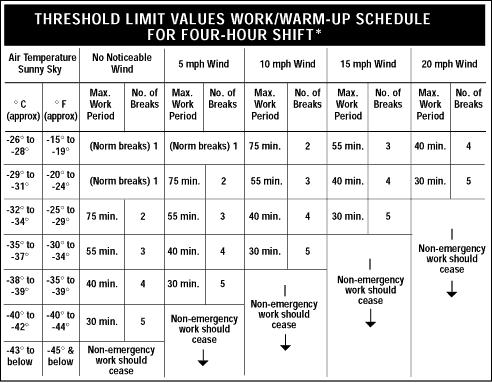Cold, wet weather makes for seasonal safety hazards for employees and customers of many business types. Most people usually assume that folks in the building trades are the primary workers and job site visitors subject to cold exposure injury. Other industries such as frozen food facilities, butchering operations and cold storage facilities have year-round exposure to injuries caused by damp and cold.
Outdoor Cold Climate Injury
When the Polar Express speeds through your area it leaves an indelible detrimental incident to your business in its wake. Workers and clients or customers cannot reach your place of business. When your area finally digs out, be alert to slippery sidewalks and parking lots and take the right precautions.
Cold Related Injuries and Illnesses
But there is more to employee protection than keeping them safe from slips and falls. Continued exposure to coldness contributes to several kinds of Cold Stress. These illnesses include hypothermia, Cold Water Immersion, Trench Foot, Frostbite, and Chilblains.
Hypothermia
Hypothermia comes from prolonged exposure to cold. Long exposure to cold results in an abnormally low body temperature. When hypothermia attacks, the brain is one of the first major organs affected and causes the person to think unclearly and move in a lumbering way. This illness is exceptionally dangerous as the lack of clear thinking allows a person to enter a dangerous situation, not know it is happening and ultimately unable to take precautionary measures. Some people suffer severe injuries or even die as a result of hypothermia.
Symptoms of Hypothermia
Early Symptoms of Hypothermia
- Fatigue
- Shivering
- Confusion and disorientation
- Loss of coordination
Late Symptoms
- Shivering stops
- Dilated pupils
- Slowed breathing and pulse
- Blue Skin
- Loss of consciousness
Hypothermia First Aid
When a worker displays symptoms of hypothermia, follow these steps:
- Alert the supervisor and call for medical help.
- Move the victim into a warm room or shelter
- Take off wet clothing
- Using an electric blanket warm the body as follows: chest, neck, head, and groin. If no blanket is available use skin-to-skin contact under loose dry layers of clothing, blankets, sheets, or towels.
- One the body temperature has risen, keep the victim dry and wrapped in blankets.
- Should the victim not have a pulse, start cardiopulmonary resuscitation (CPR)
Chilblains
Surprisingly, chilblains occurs in temperatures ranging from a little above freezing to about 60 degrees F. Chilblains happens when skin is repeatedly exposed to this temperature range. The unrelenting exposure to cold causes the capillary beds (groups of small blood vessels) just beneath the skin to become damaged. Chilblains damage is permanent and with skin exposure to similar conditions occur redness and itching returns especially to the ears, fingers, toes, and cheeks.
Symptoms of Chilblains
- Inflammation
- Itching
- Redness
- Possible blistering
- Possible ulceration in severe cases
Chilblains First Aid
People falling victim to chilblains should take the following steps:
- Slowly warm the skin
- Use corticosteroid creams to relieve itching and swelling
- Keep blisters and ulcers clean and covered
- Never Scratch
Trench Foot
This disease is the illness the military suffered from prolonged exposure to cold and dampness while wearing constraining boots or shoes in the trenches during WWI. If often occurs in temperatures above freezing all the way to about 60 degrees F. Trench foot can develop quickly with only 13 hours exposure to harsh elements.
Trench Foot Symptoms
In most case, victims complain of:
- Tingling in the feet
- Foot itching
- Burning pain in feet
- Swollen feet
- Blisters and infection can happen in advanced cases that have not had treatment.
Prevention and Treatment
Keeping feet warm and try is the best prevention measure against trench foot. Most cases respond well to moving the victim to a warm place, soak the victims feet in tepid water and then wrap the feet in dry toweling.
Frost Bite
When temperatures drop to freezing (32 degrees F) human bodies begin to constrict blood vessels nearest the skin and skin begins constricting. In extreme cold, or if the body exposure to mild to moderate cold continues for too long, the protective constriction of skin and closing of blood vessels reduces blood flow to some body parts to levels that are dangerously low. The result is freezing and the eventual death of these blood vessels. There are four degrees of frostbite and each has its own pain level.
Frostbite Treatment
Whether a person has first degree frostbite or fourth degree, the treatment is the same. Follow these treatment steps:
- Move the victim to a warm place
- If the feet are frostbitten do not allow the injured person to walk as frostbitten toes and/or feet suffer more damage.
- Use warm – not hot water for immersion of the affected area.
- Avoid massaging or rubbing the affected area as added damage is likely.
- Use only the water to warm the skin. Affected areas are numb and using any electrical device to warm the skin can lead to further burns.







